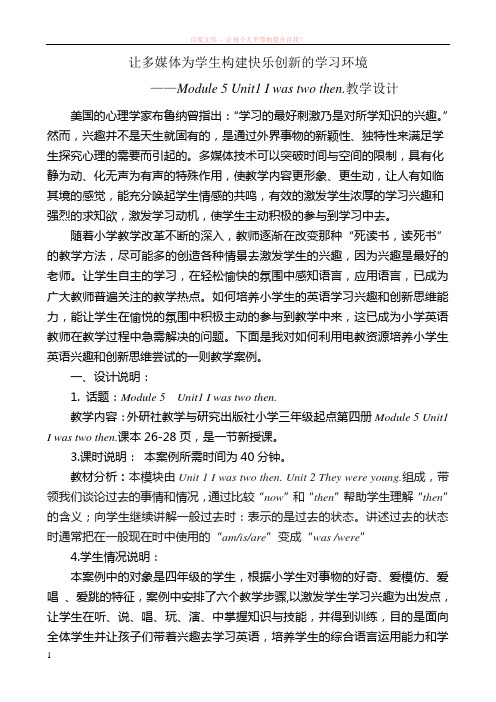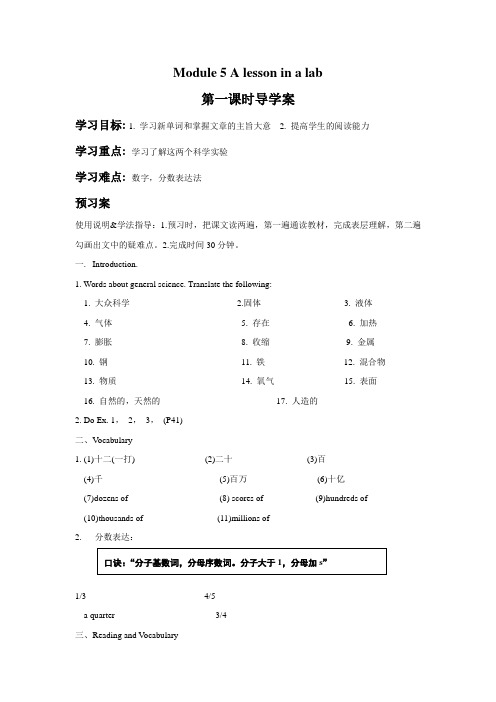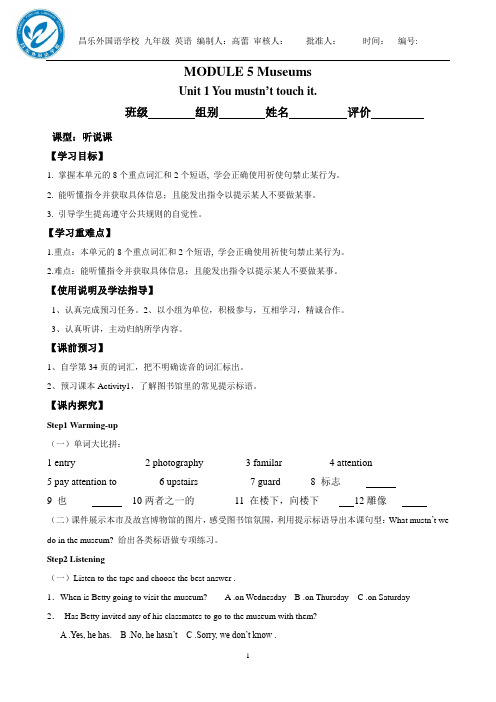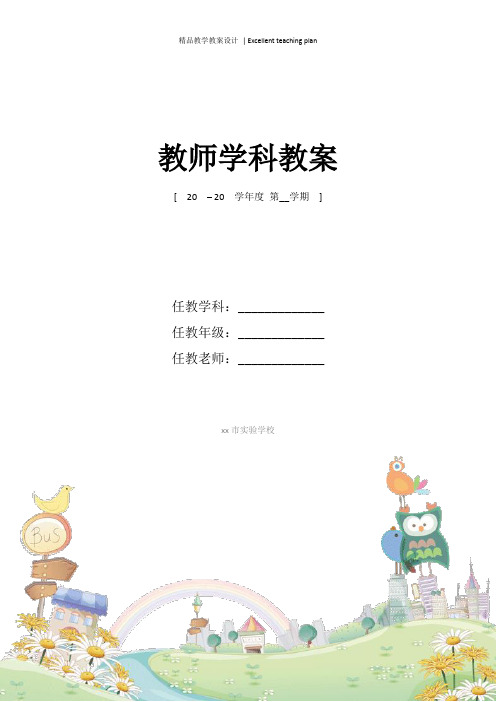Module 5 Unit 1导学案 刘颖
- 格式:doc
- 大小:34.50 KB
- 文档页数:3

让多媒体为学生构建快乐创新的学习环境——Module 5 Unit1 I was two then.教学设计美国的心理学家布鲁纳曾指出:“学习的最好刺激乃是对所学知识的兴趣。
”然而,兴趣并不是天生就固有的,是通过外界事物的新颖性、独特性来满足学生探究心理的需要而引起的。
多媒体技术可以突破时间与空间的限制,具有化静为动、化无声为有声的特殊作用,使教学内容更形象、更生动,让人有如临其境的感觉,能充分唤起学生情感的共鸣,有效的激发学生浓厚的学习兴趣和强烈的求知欲,激发学习动机,使学生主动积极的参与到学习中去。
随着小学教学改革不断的深入,教师逐渐在改变那种“死读书,读死书”的教学方法,尽可能多的创造各种情景去激发学生的兴趣,因为兴趣是最好的老师。
让学生自主的学习,在轻松愉快的氛围中感知语言,应用语言,已成为广大教师普遍关注的教学热点。
如何培养小学生的英语学习兴趣和创新思维能力,能让学生在愉悦的氛围中积极主动的参与到教学中来,这已成为小学英语教师在教学过程中急需解决的问题。
下面是我对如何利用电教资源培养小学生英语兴趣和创新思维尝试的一则教学案例。
一、设计说明:1. 话题:Module 5 Unit1 I was two then.教学内容:外研社教学与研究出版社小学三年级起点第四册Module 5Unit1I was two then.课本26-28页,是一节新授课。
3.课时说明:本案例所需时间为40分钟。
教材分析:本模块由Unit 1 I was two then. Unit 2 They were young.组成,带领我们谈论过去的事情和情况,通过比较“now”和“then”帮助学生理解“then”的含义;向学生继续讲解一般过去时:表示的是过去的状态。
讲述过去的状态时通常把在一般现在时中使用的“am/is/are”变成“was /were”4.学生情况说明:本案例中的对象是四年级的学生,根据小学生对事物的好奇、爱模仿、爱唱、爱跳的特征,案例中安排了六个教学步骤,以激发学生学习兴趣为出发点,让学生在听、说、唱、玩、演、中掌握知识与技能,并得到训练,目的是面向全体学生并让孩子们带着兴趣去学习英语,培养学生的综合语言运用能力和学生的观察、思维、创造和合作等各方面的能力,利用课件教学强化现在与过去的对比,组织学生小组合作,共同进步。

Module 5 A lesson in a lab第一课时导学案学习目标: 1. 学习新单词和掌握文章的主旨大意 2. 提高学生的阅读能力学习重点: 学习了解这两个科学实验学习难点: 数字,分数表达法预习案使用说明&学法指导:1.预习时,把课文读两遍,第一遍通读教材,完成表层理解,第二遍勾画出文中的疑难点。
2.完成时间30分钟。
一. Introduction.1. Words about general science. Translate the following:1. 大众科学2.固体3. 液体4. 气体5. 存在6. 加热7. 膨胀8. 收缩9. 金属10. 钢11. 铁12. 混合物13. 物质14. 氧气15. 表面16. 自然的,天然的17. 人造的2. Do Ex. 1,2,3,(P41)二、V ocabulary1. (1)十二(一打) (2)二十(3)百(4)千(5)百万(6)十亿(7)dozens of (8) scores of (9)hundreds of(10)thousands of (11)millions of2. 分数表达:1/3 4/5a quarter 3/4三、Reading and V ocabularyReading comprehensionⅠ. Listen to passage A and fill in the blanks.It is hard to a world without metals. Different metals have different uses,,steel is used in cars,and iron electrical equipment. When we use metals,it is important to know how they with different ,for example,water and oxygen. The of metals can be Here is a table with metals that react most ,and the metals that react least .II. Structure : Read passage B and fill in the blanksPlease fill in each blank within three words after reading the text on Page 45探究案I. Read the passage A & B carefully and answer the following question.1. Which is the best title for the passage A?A. The Different uses of MetalsB. The Reaction of MetalsC. The Reaction of Metals with WaterD. The Reaction of Metals with Oxygen2. According to Passage A,we know that is often used in cars,and is often usedin electrical equipment.A. steel,copperB. iron,zincC. steel,ironD. iron,copper3. Which metal doesn’t react with water?A. SodiumB. IronC. CopperD. Potassium4. Which metal reacts with steam?A. CalciumB. ZincC. CopperD. Sodium5. If you put a shovel (铁锨)in a damp place,it will there.A. rustB. form an oxideC. not rustD. keep the place dry6. Iron rusts in .A. dry airB. air-free waterC. ordinary airD. ordinary water7. According to Passage B,we know that the “air-free water” probably means .A. air with a lot of waterB. air without waterC. water with plenty of airD. water without airII. 须掌握的短语:1.add…往……加入……2. to 过去常常3. the area of…在……领域4.be proud 为……感到骄傲5. be supposed 应当,理应6.at 至少7.draw a 得出结论8.make 确信9. …or…或者…或者…10. be astonished 对…...感到吃惊11. find 查明12. aim 瞄准,针对13. put…把……按顺序放好14. keep…把…保持在外…15.write 写下,记下16. the air在空中17. the past…years在过去的…年里18.go 用吧;行19. learn 向…学习20. an experiment 做试验III. 合作探究.1.【课文原句】1. It is hard to think of a world without metals . P44[句型剖析] 本句属于“It +is +形容词+不定式。

MODULE 5 MuseumsUnit 1 Y ou mustn’t touch it.班级组别姓名评价课型:听说课【学习目标】1. 掌握本单元的8个重点词汇和2个短语, 学会正确使用祈使句禁止某行为。
2. 能听懂指令并获取具体信息;且能发出指令以提示某人不要做某事。
3. 引导学生提高遵守公共规则的自觉性。
【学习重难点】1.重点:本单元的8个重点词汇和2个短语, 学会正确使用祈使句禁止某行为。
2.难点:能听懂指令并获取具体信息;且能发出指令以提示某人不要做某事。
【使用说明及学法指导】1、认真完成预习任务。
2、以小组为单位,积极参与,互相学习,精诚合作。
3、认真听讲,主动归纳所学内容。
【课前预习】1、自学第34页的词汇,把不明确读音的词汇标出。
2、预习课本Activity1,了解图书馆里的常见提示标语。
【课内探究】Step1 Warming-up(一)单词大比拼:1 entry______________2 photography________3 familar_________4 attention_________5 pay attention to________6 upstairs__________7 guard______8 标志_____ ___9 也_____ __10两者之一的________11 在楼下,向楼下____ 12雕像___(二)课件展示本市及故宫博物馆的图片,感受图书馆氛围,利用提示标语导出本课句型:What mustn’t we do in the museum? 给出各类标语做专项练习。
Step2 Listening(一)Listen to the tape and choose the best answer .1.When is Betty going to visit the museum? A .on Wednesday B .on Thursday C .on Saturday2.Has Betty invited any of his classmates to go to the museum with them?A .Yes, he has.B .No, he hasn’tC .Sorry, we don’t know .(二)Listen again and do Activity 2.(三)Listen again and fill in the blanks .Betty is very 1_________ about their visit to the museum on Saturday .His mother has downloaded lots of 2______________ from the museum website. Lingling wants to see the 3__________ art . Daming’s homework is to write a report about his 4___________ museum. Betty hasn’t 5_____________ any of his classmates to come with them .But he heard two friends talking in the classroom yesterday .Step3对话处理(一)Listen and do Activity4. Then listen and check.(二)Read the dialogue and do Activity 5.(三) Read the dialogue and do Activity 6.(四)Read the dialogue and find out the language points.( 英汉互译)1期待2违反3等一下4不许进入5不准照相6集中注意力于7快点8有点儿9sth+be familiar to sb.\人+be familiar with sth. ___Step4 精讲点拨1.No shouting!禁止喧哗!这是一个由“No +v.-ing”构成的表示“禁止”的祈使句。

Module 5 ShoppingUnit 1 What can I do for you?本模块以购物为话题,分设三个课时进行学习。
本节课是这个模块中的第一课时,是一节听说课型的新授课。
作为模块的第一课,它为第二、三单元不仅提供了话题和语境,同时也为学生们后来的学习扫清语言和语法的障碍。
在第一单元中,学生的听说活动都是围绕购物对话展开的。
学生们通过学习对话,了解人物购物的地点、时间、物品、颜色、尺码、价格、数量等,感知和运用购物的交际用语。
本单元中的内容与学生们的实际生活息息相关,易于激发学生的学习兴趣和开展语言实践活动。
本单元的重点是正确理解和使用购物的词汇和核心句型。
难点是在真实的语境下正确运用购物词汇和交际用语编购物对话,将学习融入生活实践,培养用语言做事的能力。
【语言知识目标】1. 能够正确使用下列单词和词组: Mother ’s Day, size, take, may, try, try on, certainly, wait a minute, sale, price, look, fresh.2. 能正确使用下列句型:What can I do for you? I’d like to buy … for…What size does she take? May I try it on?How much is it? There’s a sale on today. I’ll take it.【技能目标】1. 能够通过听力回答问题听懂、理解本课的购物对话内容,获取该对话的大意和细节信息。
2. 能够根据不同角色正确朗读和表演该对话。
3. 能够运用购物交际用语询问物品的价格、尺寸、数量等,并进行交际和角色表演。
4. 能够根据该对话的内容和关键信息完成对话到语篇的信息转换,复述对话内容。
【情感与态度目标】在本课中,通过为家人选礼物的购物对话,培养学生要以感恩的心关爱父母和他人。
【教学重点】能够熟练运用有关购物的交际用语进行口头交际。


【外研版】七年级下Module 5导学案Unit 1 Shanghai is bigger than Hong Kong.执笔人:李家营中学李秀娟学校:姓名:班级:【课前预习学案】一、预习目标1.预习本课出现的生词的拼读2..了解对话内容3了解形容词比较的结构二、预习检查根据汉意写出下列单词并注音标:1.故乡,家乡_________________________2.比____________________3.东方____________________4.南方____________________5.千米,公里____________________6.米____________________7.高的____________________ 8.百万____________________9.海岸____________________ 10.忙的,繁忙的____________________【课中实施学案】一、学习目标(认准目标,耐住性子,一步一步往前走,加油!)1. 重点词语:answer some questions 13million people seven million people an old city2. 主要句型:Shanghai is bigger than Hong Kong.3. 核心语法:学习形容词比较级的用法4. 交际功能:学会使用形容词比较级的基本结构,并能进行两者间比较。
二、自主学习(相信自己,一定能行!)(一)听力训练1.Listen and finish Activity 1.(自主完成)2. Listen and. finish Activity 2(先自主,后小组合作)(二)对话处理1.读前听:Listen and finish Activity 3(小组合作,检查对话的理解情况)2.听后读: Listen again and choose the best answers to the questions.(Activity4)(小组合作,检查对话掌握情况)3.学后读: 朗读课文对话。
Module 5 unit 1教案Module 5 unit 1教案「篇一」Module 5 Unit 1 Getting along with othersWord powerAdjectives to describe personalityTeaching analysis:Text analysis:In this unit, we talk about “getting along with others”. So knowing others’ personality is so important to get along with others. What’s more, personality is a common topic. Each time we talk about others, we’ll mention his/her personality, so how to use the adjectives to describe personality is practical and useful. Students would like to take part in the class positively。
Students analysis:To the students in senior grade two, they have known a lot of adjectives about personality, so they can describe people’s personality in some easy words, and they will be interested in this topic。
Teaching designing idea:This part is word power, the task for me is to enlarge their vocabulary about the personality, and make students know the significance of the personality to their lives. Make the words really powerful!Teaching aims:Knowledge aims:Know some words about personalities。
教师学科教案[ 20 – 20 学年度第__学期]任教学科:_____________任教年级:_____________任教老师:_____________xx市实验学校Module5 Unit1 第1课时教案一、教学内容外研版小学英语六年级上册第五模块第一单元第一课时:Unit1 1. Look, listen and say. 2. Listen, read and act out.二、教学目标1.大多数学生能够听、说、读、写单词或短语:pleased,pen,friend,address,can2.大多数学生能够听懂并用句型:Can you...? Can I …?讲述自己的能力,通过介绍自己的情况结识笔友或网友。
3. 能够运用所学的语目知识与同伴进行交流。
三、教学重难点重点:1.听说读写单词和短语:pleased,pen friend,address,can。
2.学习句型:Can you..? Can I...? I can…难点:1.用句型:Can you..? Can I...? I can…讲述自己的能力,通过介绍自己的情况结识笔友或网友。
2. pen friend 与pen pal 的用法。
3. pleased开心的。
意思和glad/nice相似。
eg:Pleased to meet you! /Nice to meet you! /Glad to meet you!见到你真高兴!四、教学准备1.单词卡片。
2.同步课文录音、课文动画。
3.第1课时教学课件。
4.人物大明、西蒙和劳拉的头饰。
五、教学设计Step 1 Warm-up1. Have a dictation of the new words and new sentences of Module 4.2. Use the PPT to show the chant of Page 24. Let the students say the chanttogether,clap their hands or do some actions at the same time.设计思路:通过听写复习上一模块的单词和句型,通过一首英文歌谣激发学生的学习积极性,拉近师生间的距离。
教师学科教案[ 20 – 20 学年度第__学期]任教学科:_____________任教年级:_____________任教老师:_____________xx市实验学校学习过程Step1 预习部分I.写出下列单词的汉语或英语,并在课本中找出entry_________ photograpgy_________ familiar_________ attention_________ upsrairs_________ guard_________ sign_________ downstairs_________ sculpture_________ either_________pay attention to_________ as well_________II.在公共场合你都可以见到哪些标志,你能例举一些吗?_____________________________________________________________________ _____________________________________________________________________ _____________________________________________________________________ III.在博物馆你可以看见哪些标志(提示你可以做什么或不可以做什么)_____________________________________________________________________ _____________________________________________________________________Step2 Listening---Activity 21.Read through each sentence.2.Listen to the tape and underline the correct word.Step3 Listening---Activity 31.The teacher gives the following questions.Can they go upstairs?.Did they see a real sculpture?2.Listen to the tape3.Answer the questionStep4 Reading1.Activity 4.自己读对话,然后在书上完成Avtivity 4..全班检查答案.2.Activity 53.读课文画出下列短语,并写上汉语或英语科技馆_______________快走_______________ 往这边_______________期望_______________ 禁止喧哗_______________ 违反规定_______________ 上楼_______________ Hang on a minute! _______________What’s the matter? _______________No entry. _______________as well_______________ 去楼下_______________He’s gone off on his own. _______________ on one’s own_______________别摸。